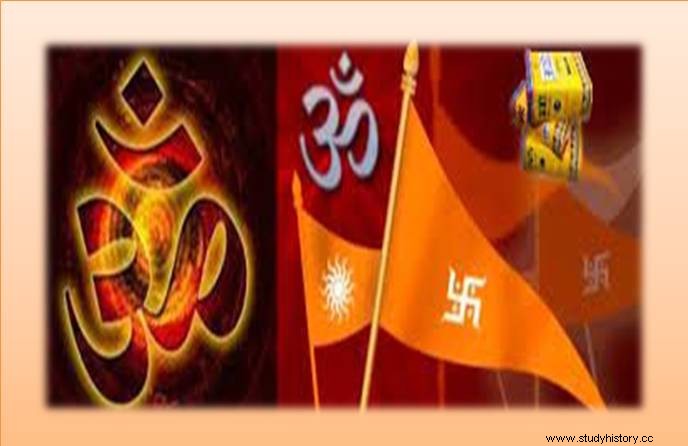
In Vedic religion, salvation was sought through rituals and people were fed up with them due to the abundance of rituals, but Buddha's religion was free from the need for rituals. The path to attaining nirvana was shown only by leading a virtuous, virtuous and tolerant life. The rules given by Buddha were so simple that it was not too difficult for the common man to follow them.
Because of this, the poor, humiliated, exploited people left the strict discipline system of Brahmin religion and started coming to the simple religious system of Buddhism. Many kings adopted Buddhism and they provided free food and clothing to Buddhist sanghas and monasteries. The organization of Buddhist monks is called the Buddhist Sangha. The monks of the Sangh lived in viharas (monasteries) and used to preach their religion to the people by roaming around. There were also certain rules for the discipline of the monks of the Sangha which should be of pure conduct and having moral force.
In the beginning Buddha did not allow women to enter the Sangha, but later on the request of the disciples, he also got permission. These women members had to follow strict rules, but their admission did not go well for the Sangh, because over a period of time, corruption spread in the Sangh due to them. The Sangha helped a lot in the propagation of Buddhism.
Triratna
Buddha, Dharma and Sangha were called 'Triratnas'. When the monks performed their daily prayers, they had to worship all three-
Buddham Sharanam Gacchami.
Dhamma Sharanam Gacchami.
Sangham Sharanam Gacchami.
Buddhist Musicians
Sangeet means conference or synod. The four Buddhist councils are of great importance in the development of Buddhism. The first Buddhist council was held near Rajagriha shortly after Buddha's Nirvana. It was a compilation of Buddha's teachings. The second Buddhist council was held in Vaishali, a hundred years after the Buddha's nirvana.
In this there was a difference of opinion among the Buddhists. Those who adopted tradition and rules only, they were called 'Sthavir'. The third council of Buddhism was held at Pataliputra during the reign of Ashoka. In this there were two classes among the followers of Buddhism. The class of progressive and reformist Buddhists called themselves 'Mahayana' and the class which remained the follower of ancient Buddhism was called 'Hinayana'. Thus there were two sects in Buddhism named Hinayana and Mahayana.
Hinayana and Mahayana
The literal meaning of 'yan' is 'ride' but here the meaning of 'yan' is 'way'. 'Heena' means low. Therefore, the literal meaning of Hinayana is the following path. The term was used by the followers of the Mahayana sect to refer to their opponents. 'Maha' means big. Hence the literal meaning of Mahayana is the Great Way.
There is a big theoretical difference between Hinayana and Mahayana. The Hinayana sect believes in the ancient form of Buddhism, but the Mahayana sect accepts its modified and changed form. Hinayana sectarians are strict and insist on following strict rules of Buddhism, but Mahayana sects are reformists and are biased towards simplifying the rigid rules of Buddhism so that Buddhism becomes more popular and a religion of the masses .
Those of Hinayana sect strive only for their own salvation, but those of Mahayana sect strive for the welfare of others as well as themselves. The Hinayana sect do not believe in the existence and worship of God, but the Mahayana sect considers Buddha as a divine being and worships Bodhisattvas along with Buddha. Bodhisattvas are people who follow the path of enlightenment.
The Hinayana sect considers Buddha a great man and is not in favor of worshiping him, but the Mahayana sect sees him as an omnipotent deity and is in favor of worshiping Buddha. The followers of the Mahayana sect are idol worshipers and worship the statues of Buddha and Bodhisattvas, but the Hinayana sect are not idol worshippers. The ultimate goal of life in the Mahayana school was to attain enlightenment, but in the Hinayana school the ultimate goal of life was the attainment of the position of Arhat.
Arhat is said to the monk who attains nirvana. Later on, in the Mahayana sect, tantra-mantra also started being propagated. The texts of Hinayana sect have been written in Pali language, but those of Mahayana sect have also composed texts in Sanskrit.
Vajrayana
When Shaivism and Shakta etc. Vaamachari sects were propagated in the country, in which tantra-mantra, magic-sorcery, sadhana-siddhis, miracles etc. were dominated, then even Buddhists were not untouched by the left-wing influence. Due to this influence, another branch called 'Vajrayana' developed from the Mahayana branch of Buddhism.
These people violated the rules of modesty and made rules for indulging in immoral deeds. As a result, texts were written on the subject of tantra-mantra and Buddhist monks became proficient tantriks of tantra learning, not being simple ascetics. The Vajrayanis adopted the five makaras of the Vamacharis – Pisces, Meat, Wine, Mudra and Sex. In Buddhist centers, the teachings of tantra-mantra and exorcism were started.
Ajivak Sampraday
Ajivaka sect also developed in Buddhism which believed in the immutability of destiny.
